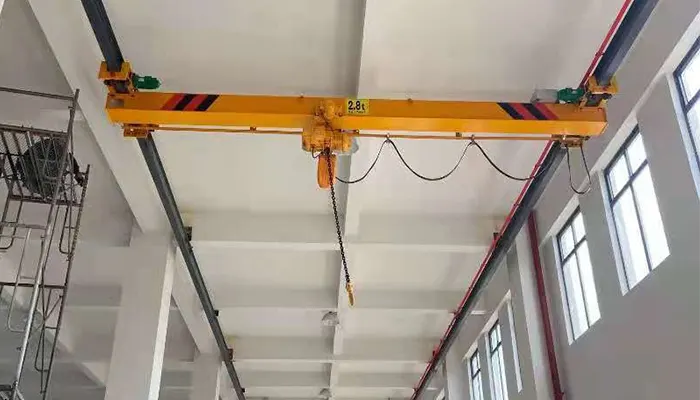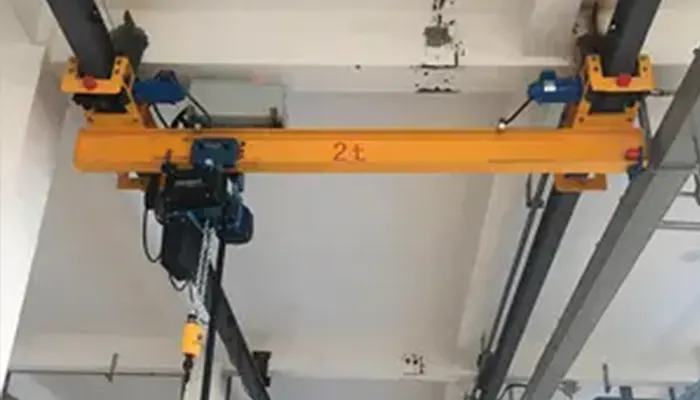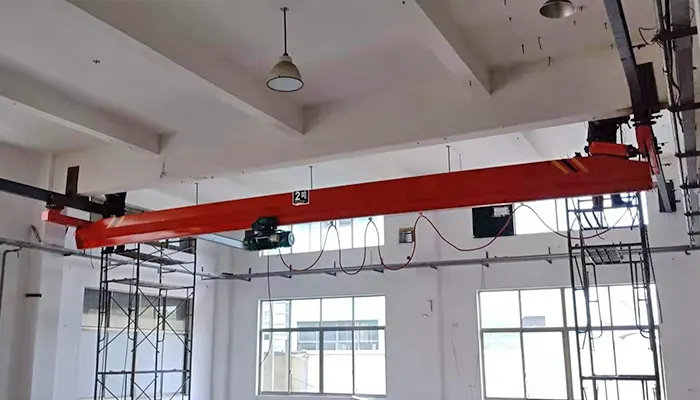Light Underhung Overhead Cranes 2 Ton for Research Laboratories
2 Ton Underhung Overhead Cranes for Research Laboratories
In research laboratories, precision is paramount. Every experiment, every analysis hinges on the ability to handle equipment and materials with utmost accuracy. Enter the unsung hero: the 2 ton underhung overhead crane. Let's delve into why these unassuming machines are the backbone of precision handling in research environments.
Underhung overhead cranes, with their sleek design and robust functionality, are the unsung heroes of industrial settings. Capable of supporting up to 2 tons of weight, these cranes operate on tracks mounted beneath the ceiling, maximizing floor space and efficiency. They are the epitome of practicality, seamlessly integrating into various environments without impeding workflow.
In research, precision isn't just a preference; it's a necessity. From delicate experiments to intricate procedures, the margin for error is razor-thin. Any deviation can compromise results, leading to skewed data or even safety hazards. Precision handling ensures that equipment, specimens, and materials are maneuvered with finesse, safeguarding the integrity of experiments and the safety of personnel.
Underhung Overhead Cranes for Light Duty Material Handling
Underhung overhead cranes, the workhorses of modern industrial settings, are defined by their unique overhead track system. These cranes operate on tracks mounted beneath the ceiling, allowing for seamless movement of loads across the length of a facility. Their primary components include:
- Bridge: The horizontal beam that spans the width of the workspace, supporting the hoist and trolley.
- Hoist: The lifting mechanism responsible for raising and lowering loads.
- Trolley: The mechanism that moves horizontally along the bridge, facilitating precise positioning of loads.
- Controls: Intuitive control panels or remote devices that enable operators to manipulate the crane's movements with ease.
When considering 2-ton underhung overhead cranes, two primary distinctions arise: single girder versus double girder configurations, and European style versus traditional designs.Single Girder vs. Double Girder Underhung Overhead Crane:
Single Girder Crane Light Duty Underrunning Crane :
Description: Single girder cranes feature a single horizontal beam (the girder) spanning the width of the workspace.
Advantages:
Cost-effective: Single girder cranes typically require less material and construction, making them more economical.
Compact: Their design is often more space-efficient, ideal for facilities with limited overhead clearance.
Suitable for Lighter Loads: While they have lower lifting capacities compared to double girder cranes, they are still adept at handling moderate loads.

Double Girder Crane Light Duty Underhung Crane :
Description: Double girder cranes have two parallel horizontal beams (girders) supporting the hoist and trolley.
Advantages:
Increased Stability: The dual girder design provides enhanced stability and strength, making them suitable for heavier loads.
Greater Lifting Capacity: Double girder cranes can typically handle heavier loads compared to single girder cranes.
Longer Lifespan: Due to their robust construction, double girder cranes often have a longer service life and require less frequent maintenance.
European Style vs. Traditional Underhung Overhead Crane:
European Style Crane Light Duty Crane Ceiling Mounted 2 Ton :
Description: European style cranes often feature a sleek, modern design with compact dimensions and advanced features.
Advantages:
Precision: European style cranes are known for their precise control systems, allowing for accurate positioning and movement of loads.
Efficiency: These cranes often boast energy-efficient components and advanced safety features, contributing to overall operational efficiency.
Modular Design: Many European style cranes offer modular construction, facilitating customization and easy integration with existing systems.
Traditional Crane 2 Ton Light Duty :
Description: Traditional underhung overhead cranes typically have a more conventional design and may be manufactured by a variety of global suppliers.
Advantages:
Wide Availability: Traditional cranes are widely available from various manufacturers, offering options to suit diverse budget and specification requirements.
Familiarity: For facilities accustomed to traditional crane designs, these models may offer a familiar operating environment and maintenance procedures.
Cost-Effectiveness: Depending on the specific requirements, traditional cranes may offer a cost-effective solution without compromising on performance or reliability.
In summary, the choice between single girder and double girder underhung overhead cranes depends on the lifting capacity needed and space constraints. Similarly, the decision between European style and traditional cranes hinges on factors such as precision requirements, efficiency considerations, and budget constraints. Understanding these distinctions enables buyers to select the most suitable crane configuration for their specific applications and operational needs.
Advantages and Limitations
Advantages:
- Space Optimization: Underhung cranes utilize overhead space efficiently, leaving valuable floor space unobstructed.
- Versatility: With customizable configurations and lifting capacities, these cranes adapt to a wide range of industrial applications.
- Precision Handling: Their precise control mechanisms enable operators to maneuver loads with pinpoint accuracy, crucial in research laboratories.
- Cost-Effectiveness: Underhung cranes offer a cost-efficient solution for lifting and moving materials, minimizing operational expenses.
Limitations:
- Weight Capacity: While 2 ton cranes are suitable for many applications, heavier loads may require alternative lifting solutions.
- Installation Complexity: Mounting tracks beneath the ceiling may pose logistical challenges during installation, requiring professional expertise.
- Maintenance Requirements: Regular maintenance is essential to ensure optimal performance and safety, necessitating ongoing attention and investment.
Precision Handling in Research Laboratories
Importance and Applications
Precision handling is the cornerstone of success in research laboratories, where accuracy and reliability are paramount. The significance of precision handling extends across various applications, including:
- Experimentation: Precise positioning and movement of equipment and samples are essential for reproducible results in scientific experiments.
- Sample Preparation: Delicate samples require careful handling to prevent contamination or damage, ensuring the integrity of research findings.
- Equipment Installation: Installing and aligning specialized research equipment demands meticulous precision to maintain functionality and accuracy.
- Hazardous Materials Handling: Safe manipulation of hazardous materials, such as chemicals or biological specimens, necessitates precise control to mitigate risks to personnel and the environment.
Challenges in Precision Handling for Research Purposes
Despite its importance, achieving precision handling in research environments presents unique challenges:
- Sensitivity of Equipment: Research equipment often comprises sensitive instruments and components that require gentle handling to prevent damage or misalignment.
- Environmental Factors: Fluctuations in temperature, humidity, or vibration levels can adversely affect precision handling, necessitating environmental controls or specialized equipment.
- Space Constraints: Limited space in research laboratories may impede the installation and operation of precision handling equipment, requiring innovative solutions to maximize efficiency.
- Human Error: Even with advanced control systems, human error remains a potential risk factor in precision handling, highlighting the importance of operator training and vigilance.
Requirements for Precision Handling in Research Environments
To meet the demands of precision handling in research laboratories, certain requirements must be fulfilled:
- Accuracy: Precision handling equipment must offer high levels of accuracy and repeatability to ensure consistent results in research endeavors.
- Adaptability: Flexibility in configuration and control enables precision handling equipment to accommodate diverse research needs and evolving experimental protocols.
- Safety: Robust safety features, such as emergency stop mechanisms and load limiters, safeguard personnel and equipment during handling operations.
- Compatibility: Precision handling equipment should seamlessly integrate with existing laboratory infrastructure and workflows, minimizing disruptions and maximizing efficiency.
- Reliability: Dependable performance and minimal downtime are essential characteristics of precision handling equipment, ensuring uninterrupted progress in research activities.
By addressing these requirements, research laboratories can effectively implement precision handling solutions that enhance experimental accuracy, efficiency, and safety, ultimately advancing scientific discovery and innovation.
Key Concerns of Crane Buyers and Users
Safety Features and Compliance
- Ensuring the safety of personnel and equipment is paramount in crane selection. Key considerations include:
- Compliance: Adherence to industry standards and regulations governing crane design, installation, and operation is essential to mitigate safety risks and liability.
- Safety Features: Integration of safety features such as overload protection, emergency stop buttons, and anti-collision systems enhances operational safety and minimizes the risk of accidents.
- Operator Training: Proper training and certification of crane operators are imperative to promote safe handling practices and prevent accidents in the workplace.
Precision Handling Capabilities and Control Systems
- The ability to precisely manipulate loads is critical in research laboratories. Buyers and users prioritize:
- Positioning Accuracy: High-resolution control systems enable precise positioning of loads, ensuring accurate placement and alignment in research experiments.
- Variable Speed Control: Adjustable speed settings allow operators to optimize handling dynamics for different loads and operating conditions, enhancing control and efficiency.
- Remote Control Options: Remote control capabilities enable operators to maintain a safe distance from loads during handling operations, minimizing the risk of injury and improving ergonomics.
Compatibility with Research Equipment and Infrastructure
- Seamless integration with existing laboratory infrastructure and equipment is essential for efficient operations. Concerns include:
- Customization Options: Crane systems should offer customizable configurations to accommodate unique research requirements and spatial constraints within laboratories.
- Adaptability: Compatibility with specialized research equipment, such as microscopy setups or analytical instruments, ensures smooth handling and installation processes without compromising functionality.
- Structural Considerations: Assessment of building infrastructure, including ceiling height, load-bearing capacity, and access points, is necessary to determine the suitability of crane installation and operation within research facilities.
Maintenance, Support, and Longevity
- Buyers seek equipment that offers longevity and minimal maintenance requirements. Key considerations include:
- Service Contracts: Access to comprehensive service contracts and technical support ensures prompt resolution of maintenance issues and minimizes downtime, preserving productivity.
- Spare Parts Availability: Availability of spare parts and components facilitates timely repairs and replacements, extending the lifespan of crane systems and reducing operational disruptions.
- Predictive Maintenance: Implementation of predictive maintenance technologies, such as condition monitoring and predictive analytics, enables proactive identification of potential equipment failures, optimizing reliability and uptime.
- Addressing these key concerns empowers crane buyers and users to make informed decisions that prioritize safety, efficiency, and long-term value in research laboratory settings.
Case Studies and Examples
Successful Implementations in Research Laboratories
University's Molecular Biology Lab: University implemented a 2 ton underhung overhead crane to facilitate the handling of delicate laboratory equipment and biological samples. The crane's precision handling capabilities enabled researchers to position samples with accuracy, enhancing the reproducibility of experiments and accelerating scientific discoveries in molecular biology.
Pharmaceuticals' Drug Development Facility: Pharmaceuticals installed underhung overhead cranes in their drug development facility to support the handling of chemical reagents and laboratory equipment. The cranes' compatibility with existing infrastructure and specialized research equipment streamlined operations, improving workflow efficiency and ensuring the safety of personnel during handling operations.
Lessons Learned and Best Practices
Investing in Operator Training: Both case studies emphasized the importance of investing in operator training to ensure safe and efficient crane operation. Comprehensive training programs equipped operators with the skills and knowledge needed to navigate complex research environments and handle equipment with precision.
Regular Maintenance and Inspections: Implementing a proactive approach to maintenance and inspections was identified as a best practice in crane management. Regular inspections and preventive maintenance measures helped identify potential issues early, minimizing downtime and prolonging the lifespan of crane systems.
Challenges Faced and Innovative Solutions
Space Constraints: One common challenge faced by research laboratories is limited space for crane installation. Innovative solutions, such as compact crane designs and ceiling-mounted tracks, helped maximize available space while maintaining efficient handling capabilities.
Integration with Research Equipment: Integrating crane systems with specialized research equipment posed a challenge due to the diverse nature of laboratory setups. Customization options and collaboration between crane manufacturers and research facility stakeholders led to innovative solutions tailored to specific research needs.
These case studies and examples highlight the successful implementation of underhung overhead cranes in research laboratory environments, along with the lessons learned, best practices, and innovative solutions that contribute to their effective utilization. By leveraging these insights, research laboratories can optimize their handling capabilities, streamline operations, and drive scientific advancements with precision and efficiency.
Conclusion: Custom Light Duty Underhung Bridge Crane for Your Needs
In conclusion, the utilization of 2 ton underhung overhead cranes in research laboratories plays a pivotal role in enhancing precision handling, efficiency, and safety. Throughout our discussion, several key points have emerged.
Firstly, precision handling stands as a cornerstone in research laboratories, underpinning accurate experimentation, sample preparation, equipment installation, and the safe handling of hazardous materials. The ability to manipulate equipment and materials with exactitude is essential for maintaining the integrity of scientific research and ensuring reliable results.
Secondly, we explored the essential components, types, advantages, and limitations of underhung overhead cranes. These versatile machines offer space optimization and precise handling capabilities, thanks to their unique overhead track system. By accommodating various lifting needs and maximizing floor space, underhung overhead cranes contribute significantly to the efficiency of research laboratory operations.
Finally, we delved into the critical concerns of crane buyers and users, ranging from safety features to maintenance and support requirements. Safety remains paramount, with a focus on features such as overload protection and collision avoidance systems. Additionally, precision handling capabilities, compatibility with research equipment and infrastructure, and the need for reliable maintenance and support services were highlighted as key considerations for crane procurement and operation.
In summary, 2 ton underhung overhead cranes serve as indispensable assets in research laboratories, facilitating precise handling, optimizing workflow efficiency, and ensuring the safety of personnel and equipment. By addressing these key points and considerations, research laboratories can harness the full potential of underhung overhead cranes to advance scientific discovery and innovation with confidence.
In closing, 2 ton underhung overhead cranes are indispensable assets in research laboratories, enabling precise handling of equipment and materials critical for scientific advancement. By addressing key concerns, embracing best practices, and leveraging innovative solutions, research laboratories can maximize the benefits of underhung overhead cranes, fostering a culture of safety, efficiency, and excellence in scientific research. As we anticipate future developments in crane technology, let us continue to prioritize precision handling and safety to propel scientific discovery and innovation forward.




